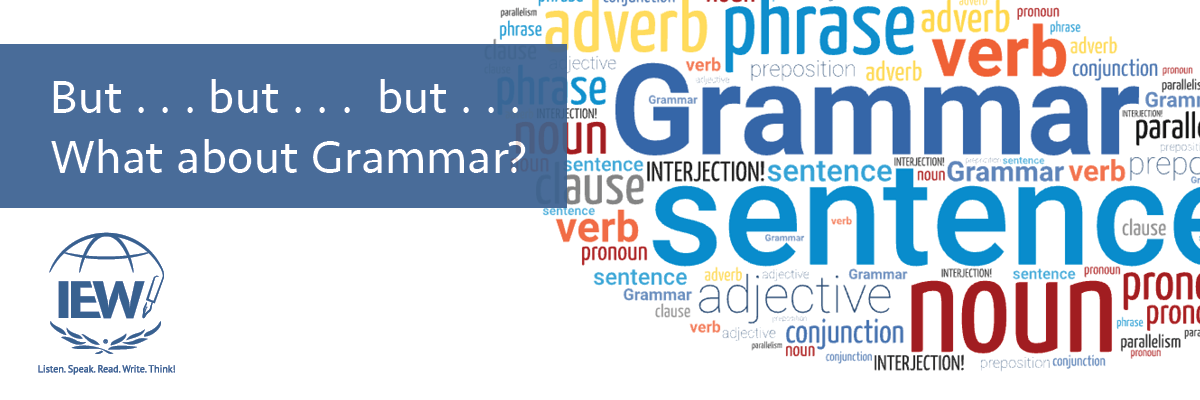
Everyone has opinions about grammar. Because grammar is foundational to writing, IEW is often asked about the teaching of grammar. In his talk But . . . but . . . but . . . What about Grammar? Andrew Pudewa outlines four paradoxes of teaching English grammar and three divisions of language usage. Subsequently, he details the two worst and two best ways to teach grammar.
A paradox is a statement that seems contrary to common sense and yet is perhaps true. Four paradoxes make learning and teaching the English language frustrating. First, grammar is an imperfect subject but is taught as though it were perfect. Unlike math, which always has a right answer, in grammar there can be opinions about what is right. For a rousing debate among grammarians, just mention the Oxford comma. What may seem like an exception is often a more advanced punctuation rule. For example, young students learn that who/which clauses require commas. As students gain experience in writing and in grammar, they learn that nonessential who/which clauses require commas, whereas essential who/which clauses do not. Teaching and learning the nuances can be frustrating for teachers and students alike, especially when the students are developmentally too young to understand the complexity of language.
The second paradox is that a knowledge of grammar is not a prerequisite for writing, but proper grammar is essential for precise communication. In conversation with Andrew, a professional ghostwriter with many titles to his credit claimed that he did not need to know grammar. What he meant was that he did not need to know the whole system and structure of the English language because as an English speaker he knew how to do it. However, good writers must use proper grammar because improper grammar and imprecise language lead to confusion and misunderstanding. An Arts of Language podcast “Why Great Grammar Doesn’t Guarantee Great Writers” (Episode 304) provides the research that explains this paradox.
The third paradox follows naturally from the second. Grammar is an important thing, yet it is almost completely irrelevant to children. Andrew uses the analogy of riding a bike to illustrate this concept. If you ask children how they ride a bike, they do not articulate the biology and physics involved in that process. They tell you they just do it. Because children have been acquiring language skills since birth, they intrinsically know the word order of a sentence without knowing the grammar rules or ordering principles of language. Traditional grammar exercises that are not related to the writing process feel contrived and pointless to them.
Finally, analytical grammar is not an activity for elementary students. Simply put, what teachers can expect students to understand about the complex intricacies of English grammar and apply in their own writing depends on students’ developmental levels and ability to reason. Young children memorize parts of speech and rules. Adolescents mark parts of speech and recognize the rules while older teens and young adults analytically use persuasive language and purposefully follow the rules. Oftentimes grammar and writing instruction requires students to put all of these skills together before they are developmentally ready. This paradox is best explained in relation to the three divisions of grammar.
There are three stages of learning grammar: inherent, applied, and analytical. At the inherent or inherited stage, young children acquire language from their environment. At this stage elementary students can memorize terms and identify them in sentences. Furnishing their minds with sophisticated language through poetry and reading, even reading aloud, is imperative. At the applied stage of grammar, middle school students can recognize and correct grammar mistakes. This recognition is based on their inherent grammar, so students may know what to correct but not why it needs to be corrected. The analytical stage is where grammar literacy is built. Older students understand proper grammatical terms as well as the rules and intricacies that govern their use. They can apply them purposefully and appropriately to craft strong arguments and persuasive discourse. Learn more about these stages in “How Much Grammar Is Enough?” (Episode 389). For grammar instruction to be relevant and effective, concepts and applications must be introduced to students in each stage at the correct time and in the direct context of writing.
What are the worst and best ways to teach grammar? The grammar textbook approach, when grammar is taught out of context in isolation, does not work. Equally disastrous is the idea that grammar does not need to be taught at all because children will “just pick it up” in everyday language usage. English grammar is best taught in the context of writing and is often learned and understood through the study of a foreign language. “The Great Grammar Give and Take” (Episode 228) delves deeper into how the Structure and Style for Students and Fix It! Grammar programs reconcile these grammar paradoxes and introduce students to grammar in an age-appropriate sequence in the context of their own writing.
This blog post recaps Andrew Pudewa’s But . . . but . . . but . . . What about Grammar? talk. Listening to Andrew’s talk and reading the blog posts along with listening to the podcasts linked in this article provide a compilation of the research, experience, and practice that has gone into developing IEW’s Structure and Style method and Fix It! Grammar program. Using both products in tandem provides a proven and successful method of developing competent and confident communicators who have a deep knowledge and understanding of English grammar and usage.
by Andrea Pewthers
